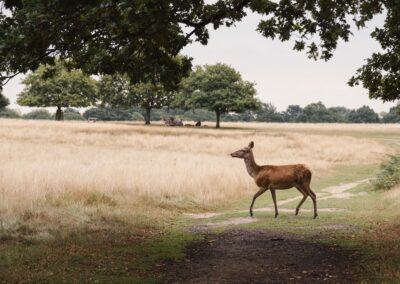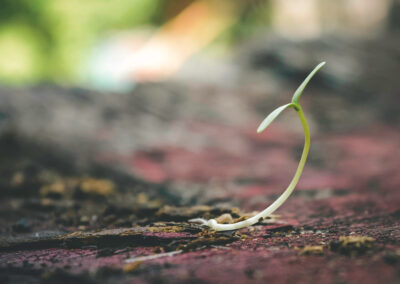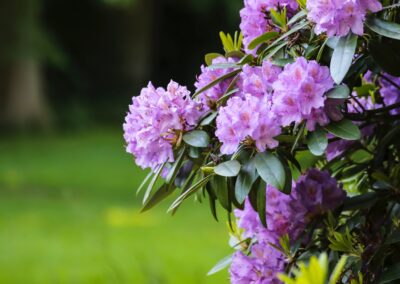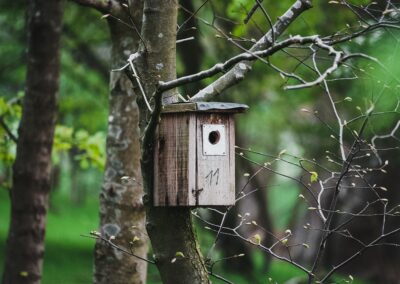WHAT WE DO
Woodland Management
Active management of our woodlands results in a varied and biodiverse habitat, offering homes, food and shelter to a wide range of wildlife.
The question is often raised – why manage woodlands at all, should we not just leave it to nature?
Although a minimal-intervention approach is desirable, few woodland habitats in the UK today have the resilience and ecological integrity to be left unmanaged without it resulting in further loss of biodiversity. This is due to the substantial impact of centuries of human activity – the structure and composition of the woodlands having been altered by the introduction and planting of non-native species, often in single-species, even-age stands. This impacts the wider ecology of the woodland habitat. In addition, we have to consider that there are missing features of the ecosystem (such as large herbivores) and influences from the wider landscape.
Single age stands of trees have resulted in areas of closed canopy with very little able to grow in the understory. The understory of woodlands is naturally composed of various ages and sizes of trees and shrubs and these provide food and shelter for wildlife, shade for ground flora and will respond to fill gaps in the canopy when trees die.
Where many trees have been harvested or fallen at once, the woodlands have become dominated by course vegetation such as bracken and bramble. Without the appropriate levels of shade to regulate these, the rich flora of the woodland floor including wild-flowers, herbs and mosses, can be smothered. Redressing imbalances in light levels through thinning and planting is one of the key aspects in restoring a woodland to health.
Another key part of our management is responding to the threats of invasive and non-native species. For example, rhododendron has the potential to smother the native ground-flora, spread disease and can acidify the soil preventing the natural regeneration of native tree species. Introduced species such as fallow deer can substantially impact the natural regeneration of trees and shrubs.
Two major challenges we currently face are rhododendron and Phytophthora ramorum. Phytophthora ramorum is a plant disease which spores in the rhododendron and primarily effects sweet chestnuts and larch. A Statutory Plant Health Notice resulted in the forced clearance of around 5 acres of larch in 2014/15 at the western end of Clarrick woods and demonstrates the enormous task ahead to bring these local landmark woods back to health.
We are engaged in a race against time to get on top of this situation and avert a clear-fell order similar to the Alpines’ larch.
Some areas of the woods require some work to aid their restoration. The thinning of conifer trees and dead sweet chestnut trees on some of the steeper less accessible slopes will enable the development of broadleaf species. Because of the locations of these sites some of the timber will remain as standing and fallen trees, left to decay naturally. This will provide a valuable deadwood habitat.
However, the thinning of the PAWS (plantation on ancient woodland sites) needs to be a considered so that light levels increase slowly without shocking existing remnants of ground flora or enabling coarse vegetation to dominate.
Single species, single aged stands can increase a woodland’s vulnerability to pests and diseases, climatic changes, and natural hazards such as wind damage. Natural woodland is never composed of single species blocks, and this approach can have a negative effect of the biodiversity of a site. The careful restoration of the woodland is a priority activity to enhance its value for wildlife and make it more resilient to disease.
Existing areas of broadleaves will be maintained and expanded as opportunity arises, through natural regeneration and/or planting. Ideally, we try to support the natural regeneration of the woodland because locally native strains will have better resilience and adaption to the local conditions.
However, planting is required as introduced species such as sycamore tend to dominate and, without protection, saplings are susceptible to deer damage.
We are planting to create a more mixed woodland composition, with mixed high-canopy trees and a more diverse shrub layer. Trees planted will be native to Cornwall and our planting choices informed by local conditions and advice from the existing woodlands community.
Some of the tree species we are planting are: oak, hazel, wild cherry, hawthorn.
A non-native species is one that has been transported from its native range to a new region with help from humans. An invasive, non-native species is one that has a negative impact on the environment, economy or our health and way of life.
Invasive plant species can harbor or spread diseases onto trees. For example, rhododendron (Rhododendron ponticum) is an ornamental shrub introduced by the Victorians for its spring flowers but it can carry the tree disease Phytophthora ramorum. This has now affected seven acres of larch and ten acres of sweet chestnut. The rhododendron doesn’t die immediately – instead it acts like a reservoir for the disease, allowing the Phytophthora to release spores onto nearby trees.
We are progressively clearing the sections where the rhododendron is prevalent with the help of volunteers.
Pigshill woods are valuable habitat for wildlife, an important landscape feature and a popular recreational asset for local people. However, managing the woods requires significant work and this has been inconsistent for some decades. Some areas of the woodland are in a poor condition with decreasing wildlife value, poor infrastructure, and overcrowded trees. We hope that we can reverse this decline and offer the woods sustainable future.
In addition to thinning, planting and invasive species control we are also:
- Restoring our ponds
- Installing and monitoring nest-boxes for a range of different bird species
- Managing glades and rides to create and maintain open spaces within the woods
We are working with Cornwall Wildlife Trust and the Woodlands Trust to better understand our woods and how to manage them moving forward.
Timber processing & coppice
Making best use of the extracted timber and adding value to it wherever possible will be vital to ensure the economic viability of the woods.
Wood fuel
An early priority for the CIC has been to establish a wood fuel business providing logs to the local area. Wood fuel as an early project is particularly suitable for Pigshill & Clarrick woods. Sales are mainly delivery based, including small bags through local campsites and bulk loads. There is a good local market for wood fuel and the local provenance of the logs and social impact of choosing to purchase them will be a significant selling point to local people.
Timber products
Making things from the timber extracted from the woods is both a great way to add value to the timber and involve people in the woods. We have the capacity to mill our timber on our trailer saw-mill to produce planks and posts.
A major selling point of timber products from our woods is the local nature of production and supply; supporting local economy and reducing transport impact.
Post, poles and charcoal
Coppicing is an ancient method of sustainably managing woodlands. When trees such as hazel are cut, they regrow from the root base the next year. This cycle is on average 8 years between harvests and it provides useful timber in the form of hazel rods. These can be used for a range of things such as fencing, hurdle making, bean poles and utilization by local creatives. A key output of our hazel coppice is charcoal; made on site in our kiln.
Coppicing also provides excellent habitats for wildlife. After a block (coupe) of hazel has been harvested, more light reaches the woodland floor. This encourages a diverse ground flora to re-develop, providing food for invertebrates, mammals and birds. When 8 hazel coupes are harvested in rotation yearly, it provides the perfect variety of habitats in succession to maximize biodiversity.



